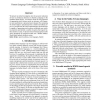493 search results - page 39 / 99 » Fitting hidden Markov models to psychological data |
NIPS
2008
13 years 10 months ago
2008
Neural activity is non-stationary and varies across time. Hidden Markov Models (HMMs) have been used to track the state transition among quasi-stationary discrete neural states. W...
EMNLP
2004
13 years 10 months ago
2004
We compare and contrast two different models for detecting sentence-like units in continuous speech. The first approach uses hidden Markov sequence models based on N-grams and max...
INTERSPEECH
2010
13 years 3 months ago
2010
We present an initial investigation into the acoustic realisation of tone in continuous utterances in Sepedi (a language in the Southern Bantu family). An analytic model for the g...
FGR
1998
IEEE
14 years 1 months ago
1998
IEEE
Automated recognition of facial expression is an important addition to computer vision research because of its relevance to the study of psychological phenomena and the developmen...
AAAI
1997
13 years 10 months ago
1997
We address the problem of visually detecting causal events and tting them together into a coherent story of the action witnessed by the camera. We show that this can be done by re...

